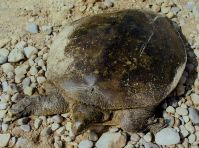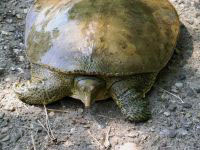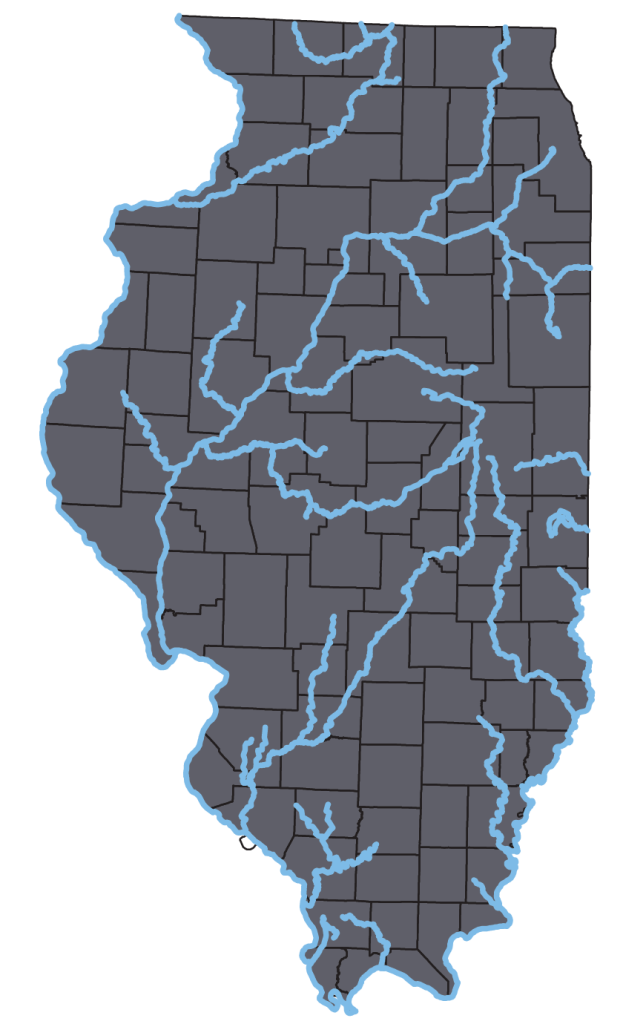Apalone spinifera (Le Sueur, 1827)



Key Characters: Anterior margin of carapace decked with small spines or tubercles; conspicuously patterned feet; snout squared off with horizontal ridge projecting from median septum into each nostril.
Similar Species: Smooth Softshell. See Key to Adult Turtles of Illinois for help with identification.
Subspecies: Five subspecies are currently recognized in the United States. Only the Eastern Spiny Softshell, A. s. spinifera is found in Illinois. Smith (1961) considered Illinois populations to be mainly A. s. spinifera, but noted the influence of Western Spiny Softshell, A. s. hartwegi Conant & Goin, 1948 (Occ. Pap. Mus. Zool.Univ Michigan, No. 510: 1-19) in northwestern Illinois. The latter subspecies was synonymized with A. s. spinifera by McGaugh et al. (2008, Zoologica Scripta 37: 289-304).
Description: Large (up to 38 cm CL) turtle with carapace pattern of dark circles and spots in males and juveniles; larger, irregular blotches in females. A pair of dark-bordered light stripes runs from snout to eyes; another pair of similar stripes extends posteriorly from the eye onto the neck; a third pair of short light stripes extends back from mandible. Male smaller with rough sandpaperlike carapace, and conspicuously longer, thicker tail than female.
Habitat: Rivers, backwaters, lakes, and ponds.
Natural History: Often seen basking on logs. Readily bites. Its sharp-edged jaws, hidden beneath the fleshy lips, can deliver a painful wound. Feeds on aquatic insects, crustaceans, and fish. May actively forage for prey or bury itself in the sand to wait for unwary animals to come within striking range. Female nests in sand or mud from mid-May into July, lays an average of 18 round, brittle-shelled eggs (ca. 28 mm) per clutch, up to four clutches per year.
Status: Less susceptible to siltation and pollution than the Smooth Softshell. Remains common in most river systems within the state.
Etymology: Apalone – apo (Greek) meaning separate; alone (Anglo-Saxon) meaning solitary; or apalos (Greek) meaning soft, tender; spinifera – spina (Latin) meaning thorn; fero (Latin) meaning carry, ‘to bear’.
Original Description: Le Sueur, C.A. 1827. Note sur deux especes de tortues du genre Trionyx Gff. St. H. Mem. Mus. Hist. Natur., Paris. Vol. 15.
Type Specimen: Syntypes. 8 specimens, MNHN 1949, 6957, 8807-12. 8808 designated lectotype by Webb (1962. University of Kansas Publications. Museum of Natural History. Lawrence. 13 (10): 429-611).
Type Locality: “Newharmony, sur le Wabash” [=New Harmony, Wabash River, Posey County, IN]
Original Name: Trionyx spiniferus Le Sueur, 1827
Nomenclatural History: Kennicott (1855. Catalog of animals observed in Cook County, Illinois. Ill. State Ag. Soc. Trans. 1853-54 (1):577-595) used the name Trionyx ferox (Schneider, 1783), apparently in reference to the Eastern Spiny Softshell. Davis & Rice (1883. List of Batrachia and Reptilia of Illinois. Bulletin of the Chicago Academy of Sciences. vol. 1, no. 3) used Aspidonectes spinifer. Other names used in reference to Illinois populations include Amyda spinifera, Platypeltis spinifera, Amyda ferox, and Trionyx spinifer.


